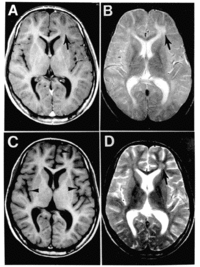
Photo from wikipedia
Routine assessment of thyroid function during hospitalization for COVID-19 is not recommended by the World Health Organization clinical management guidelines [1]. However, worsening of pre-existing thyroid dysfunction or de novo… Click to show full abstract
Routine assessment of thyroid function during hospitalization for COVID-19 is not recommended by the World Health Organization clinical management guidelines [1]. However, worsening of pre-existing thyroid dysfunction or de novo occurrence of thyroid disease, possibly caused by infection itself, should not be missed, to avoid misleading work-up, unnecessary medicalization, and its potential negative prognostic impact [2]. We hereby describe a case of thyrotoxicosis occurred during hospitalization for COVID-19. A 69-year-old woman experienced mild fever, cough, and dyspnea during the recovery phase following back surgery. A naso-pharyngeal swab test for SARS-CoV-2 was positive, and chest highresolution computed tomography (without iodinated contrast agents) showed bilateral ground glass areas typical of SARS-CoV-2-related interstitial pneumonia. The patient was then hospitalized at our dedicated COVID-19 department. The patient had longstanding non-toxic nodular goiter with a dominant benign nodule in the right lobe, and repeatedly documented euthyroidism. Because of recent surgery, she was under treatment with high-dose painkillers, including tramadol, acetaminophen, and low-dose morphine in case of severe pain. Non-steroidal anti-inflammatory drugs (NSAIDs) were not prescribed because of hypersensitivity. Medical therapy with hydroxychloroquine plus lopinavir/ ritonavir and low-flow oxygen therapy were initiated as prescribed on hospital admission. No iodine-containing drugs were given. From day 5, the patient started complaining of palpitations, insomnia, and agitation, despite being afebrile and clinically stable. She had no neck pain. Thyroid function assessment showed suppressed serum thyroid-stimulating hormone (TSH: 0.08 mU/l, normal range 0.27–4.2) with increased serum-free thyroxine (FT4: 24.6 pg/ml, normal range 0.3–17) and free triiodothyronine (FT3: 5.5 pg/ml, normal range 2–4.4). TSH-receptor antibodies, thyroperoxidase, and thyroglobulin antibodies were all negative. Empirical therapy with methimazole was initiated. Five days later, thyrotoxicosis worsened (TSH 0.02 mU/l, FT4 29.7 pg/ml, FT3 5.6 pg/ml), and serum thyroglobulin was elevated (187 μg/l, normal range 3.5–77). Bedside thyroid ultrasound showed an enlarged hypoechoic thyroid, decreased vascularity and the known 30-mm homogeneous nodule in the right lobe (with peripheral vascularization). At thyroid scan using Tc 99-m, there was no uptake. Because NSAIDS could not be employed, methimazole was discontinued and steroids were given, starting with 40 mg intravenous methylprednisolone for 3 days, then continuing with 25 mg oral prednisone, to be progressively tapered over 4 weeks or more, according to clinical response [3]. Within a few days, symptoms markedly improved; 10 days after starting steroids, biochemical thyrotoxicosis substantially improved (FT4 21.9 pg/ml; FT3, 3.07 pg/ml). Of note, naso-pharyngeal control swab test for SARS-CoV-2 resulted positive 2 months after the first diagnosis, though respiratory symptoms were completely solved. Clinical presentation, ultrasound features, lack of thyroidal uptake, high serum thyroglobulin levels, and the absence of thyroid autoantibodies suggest a thyroid-destructive process compatible with a diagnosis of subacute (De Quervain’s) thyroiditis, possibly triggered by SARS-CoV-2 * S. Ippolito [email protected]
Journal Title: Journal of Endocrinological Investigation
Year Published: 2020
Link to full text (if available)
Share on Social Media: Sign Up to like & get
recommendations!